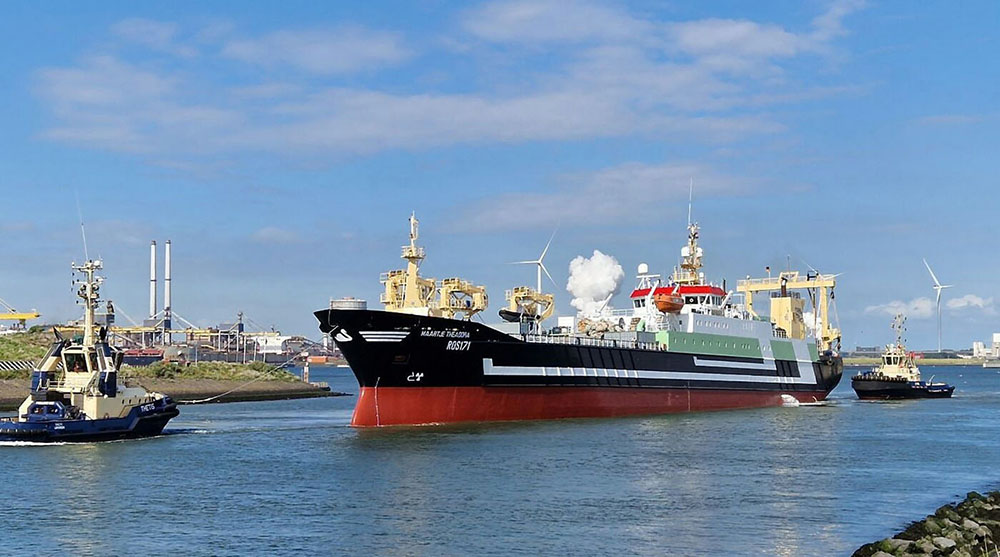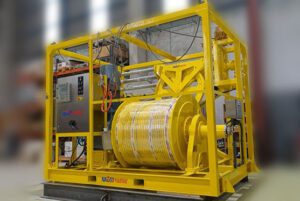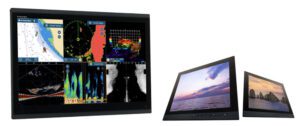
An exploration of what’s new in electronics for fishing trawler boats.
Over the past year or so, companies that sell and/or manufacture technology for fishing trawlers have been actively crafting, marketing and selling goods for commercial fishing vessels.
Fishermen’s News reached out to various companies to gather information about what new products have entered the market over the past 12-plus months, as well as other notable developments within businesses in the industry.
Naust Marine
In late July, Naust Marine—which is based in Iceland, but has a U.S. location in Poulsbo, Wash.—announced production of its new umbilical winch for marine electrical engineering and installation services company MJR Power and Automation.
The winch is to be used on the deck of a supply vessel owned by Subsea Micro Piles Ltd. in Ireland, plus function as a portable unit for various subsea operations.

According to Naust, the winch allows the deployment of an umbilical cable for the supply of services necessary for the bell and divers in water. The umbilical winch, the company has said, is fitted with a tensioning device that maintains a positive “pull” on the umbilical to prevent excess umbilical being paid out.
The umbilical winch is supplied with right-angle arrangement; a storage capacity of 400 mts; 32.5 mm umbilical cable; special slip ring 176/291 model, and an electric storage cabinet with local control, according to Naust.
About a month before the announcement of the umbilical winch, Naust delivered an electrical spooling gear (ESG) system with controls and touch screen to German freezer trawler Maartje Theadora. The vessel, which has a length of 460 feet (140.80 meters), a width of 61 feet (18.68 meters) and a displacement of 9,436 total deadweight tonnage, is among the largest fishing vessels in Europe.
The trawler, which was built in 2000, is mainly used for pelagic fishing and sails for Westbank HochseeFischerei GmbH, a subsidiary of the Dutch fishing group Parlevliet & Van der Plas B.V.
“Naust Marine’s ESG solution will ensure safe and reliable reeling and will be a good addition to the deck machinery already onboard,” Naust said in a statement. “The Maartje Theadora will experience superior reeling by allowing the wheelhouse to easily adjust speed, for different diameters of rope/wire to ensure consistent reeling.”
The ESG system was delivered as a stand-alone package which can easily fit the winch type onboard with minimum modification, Naust said.

Furuno
In July, Camas, Wash.-based Furuno USA introduced two new high-definition monitors, the 15-inch MU152HD and the 19-inch MU192HD, both of which are designed for use with the company’s black box systems, but can also be used with various other compatible electronics.
The MU152HD (XGA, 1024×768) and MU192HD (SXGA, 1280×1024) feature ultra-bright 1000 cd/m2 bonded LCD panels with black bezels. The monitors’ interface options allow for DVI-D, HDMI, RGB or Composite Video inputs with picture-in-picture capability to accommodate more than one video source, according to Furuno.
While the new displays are designed for flush-mount installations, the company has said that optional hardware is available for bracket mounting.
“Built to withstand the toughest marine conditions, the MU152HD and MU192HD are the perfect monitors to pair with many of Furuno’s high-end marine electronics, including a wide range of black box chart plotters, fish finders, sonars and radars,” the company said in a statement. “These new HD monitors can also be paired with many compatible systems from other manufacturers.”
The introduction of the monitors came five months after Furuno announced two new, extra-large 22-inch and 24-inch monitor models to its NavNet TZtouch3 product line.
The new models, named TZtouchXL, are super-wide, full-HD (1920×1080 FHD resolution) multi-function displays, and include the features in the standard NavNet TZtouch3, according to the company.
“The TZT22X and TZT24X deliver all of the features that make NavNet TZtouch3 a breeze to operate, plus you can split these large screens into six different windows,” Furuno explained in a statement. “The edge-swipe feature makes finding what you need simple and intuitive.”
Users can swipe from the left to view or hide navigation data, from the right to see all their shortcuts, from the bottom to view layer options with new organizational tools, or swipe down from the top to easily access their own customized Quick Pages, according to Furuno.
“A single tap selects most options, so you’re never more than a swipe and tap away from the most commonly accessed features,” the company explained, adding that TZtouchXL comes with 10 preset screen configurations, or users can build their own custom displays with up to a six-way split-screen layout.

Sea Machines
In June 2022, Sea Machines Robotics, a Massachusetts-based developer of autonomous command and control and advanced perception systems for marine industries, unveiled its AI-ris, a marine computer-vision navigation sensor designed to improve safety and performance while vessels are underway.
The company revealed the new technology during Seawork2022, the largest European commercial marine exhibition. The AI-ris (Artificial Intelligence Recognition and Identification System) technology, according to Sea Machines, uses digital cameras and AI-processing to detect, track, classify and geolocate objects, vessel traffic and other potential obstacles in the majority of operational conditions, day or night, to equip crew with best-in-class situational awareness.
Additionally, computer vision helps improve safety for vessels and is also “a critical technology for the advancement of autonomous command and control systems,” according to the company.
“The need for this technology is clear,” Sea Machines said in a statement. “Boats and ships operate in the planet’s most dynamic environment and the limitations of conventional navigation sensors leave the bulk of perception work to the human eye and brain for continuous scanning of the waterway. Fatigue, distraction and confusion can lead to misses and mistakes.”
The U.S. Coast Guard reported that in 2022, collisions (vessels, objects, groundings) were the most frequent first event in recreational boating accidents, contributing to 55% of accidents, 21% of deaths and 53% of injuries.
Operator inattention, operator inexperience, improper lookout, excessive speed and machinery failure ranked as the top five primary contributing factors in the incidents.
“The commercial marine industry suffers from similar challenges. Sea Machines designed AI-ris to be ever-alert, with the ability to deliver predictable operational results that can improve vessel reliability, as well as eliminate liabilities caused by human error,” the company said. “Now commercially available, this technology can radically improve vessel safety.”
Sea Machines CEO Michael G. Johnson has said that his company is dedicated to building the future of ocean mobility.
“We envision a future with fewer accidents at sea. We are revolutionizing marine navigation with data-driven intelligence, autonomy and connectivity,” he said. “The superior capabilities of computer vision and AI will ensure a safer, more productive voyage.”
“AI-ris is always scanning for obstacles and can alert the operator of potentially dangerous situations. It also labels objects very small in size, like swimmers, kayakers or animals, to those very large, like another ship,” Chief Technology Officer Trevor Vieweg added. “With the ability to detect, classify and geolocate such targets via optical sensors, AI-ris augments and surpasses the capabilities of existing marine sensor technologies, like radar and automatic identification system(s).”
In the future, he added, the technology could also help responders detect marine oil spills.
Inov8v Marine Group
Not all news in the trawl technology industry over the past year was product-related.
Last summer, three West Coast companies —Western Marine Electronics (WESMAR), Arcturus Marine Systems (ABT-TRAC) and SmartCatch—announced the formation of a new marine technology company, Inov8v Marine Group, encompassing all three brands.
Inov8v Marine designs and fabricates propulsion, vessel stabilization, sonar and underwater video technology for both pleasure and commercial fishing craft. The group formed through the consolidation of Arlington, Wash.-based ABT-TRAC, Northern California-based SmartCatch, and Lynnwood, Wash.-based WESMAR.
WESMAR, which says it introduced the world’s first solid-state sonar in 1965, has technology that falls into three segments: sonar, vessel stabilizers and bow-and-stern thrusters. According to the company, it’s innovations include the world’s first video sounder, first continuous picture color sonar and introduction of the first dual-propeller, counter-rotational bow thruster.
ABT-TRAC began as Arcturus Marine Systems in 1986. Best known in the yachting industry, ABT-TRAC specializes in stabilizers, bow-and-stern thrusters and hydraulic systems. Its innovations include electrically driven stabilizers that deliver hydraulic performance without hydraulic overhead.
SmartCatch began in 2012 with the mission of using innovative “eyes in the net” underwater video technology to maximize commercial fishing profitability while reducing wasteful destruction of non-target fish, or bycatch.
According to WESMAR founder Roger Fellows, combining the three companies has produced a more complete, higher-performing product line, with improved service after the sale.
“Inov8v Marine Group is in a stronger position to deliver than our component brands would be by themselves,” Fellows, who is now president of Inov8v, said.
“Whether for pleasure or business, our customers tend to be people who find themselves in demanding marine environments, far from home,” Fellows said. “They value systems that perform. We founded Inov8 Marine Group to deliver safety, pleasure and profit to the people who need them most.”
Mark Edward Nero can be reached at mark@maritimepublishing.com
